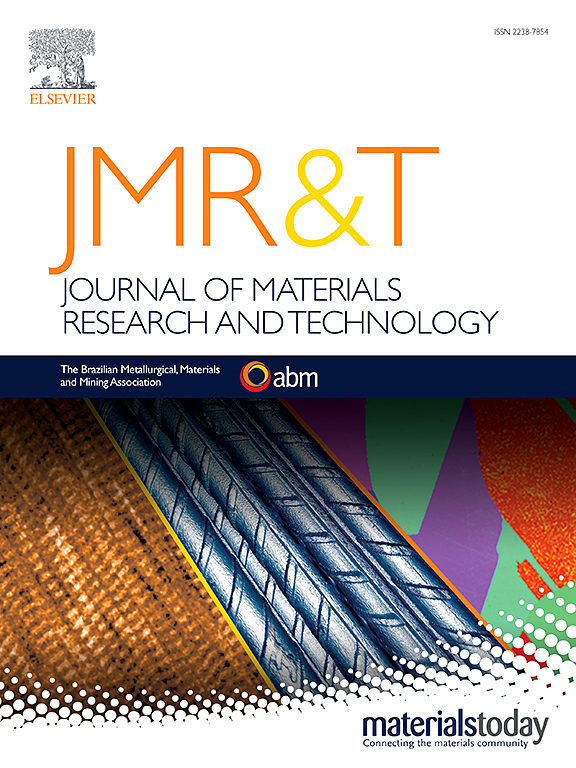Impact of selected tramp elements in medium carbon steels on the deformation behavior of non-metallic inclusions and phase transformations
IF 6.2
2区 材料科学
Q1 MATERIALS SCIENCE, MULTIDISCIPLINARY
Journal of Materials Research and Technology-Jmr&t
Pub Date : 2025-03-17
DOI:10.1016/j.jmrt.2025.03.150
引用次数: 0
Abstract
Scrap recycling is one of the major pillars of the steel industry's green transformation. It is important, however, to consider the available scrap's tramp element levels. While non-metallic inclusions (NMIs) and tramp elements are both considered to be part of steel cleanness, their interplay is hardly investigated. Therefore, this work focuses on the impact of tramp elements on NMIs in three medium carbon steels in solid state. The elements studied are copper, molybdenum, tin, and nickel. The deformation behavior of NMIs of the steels is evaluated by dilatometric deformation via the change of aspect ratio using automated SEM/EDS analyses. Furthermore, the effect of these tramp elements on the microstructure using quenching dilatometry is studied via dilatometric curves and light microscopy after etching. It is shown that especially copper (additions of 0.25 wt.-% and 0.5 wt.-%) impacts the deformation behavior of NMIs by reducing the change of aspect ratio and also increases the share of hard phases in the microstructure where in one steel bainite is formed while without copper the microstructure is ferritic-pearlitic with the same cooling rate. However, adding 0.1 or 0.2 wt.-% nickel causes the opposite effect on deformation and microstructure while the added levels of tin (0.03 wt.-%) and molybdenum (max. 0.08 wt.-%) have not influenced the NMI deformation behavior significantly. With the changes in NMI behavior and steel microstructure, fracture toughness has to be re-evaluated.
中碳钢中选择不稳定元素对非金属夹杂物变形行为和相变的影响
废钢回收利用是钢铁行业绿色转型的重要支柱之一。然而,考虑可用废料的不定期元素级别是很重要的。虽然非金属夹杂物(NMIs)和杂质元素都被认为是钢的清洁度的一部分,但它们的相互作用很少被研究。因此,本研究着重研究了三种中碳钢在固态状态下不稳定元素对nmi的影响。所研究的元素有铜、钼、锡和镍。利用自动扫描电镜/能谱分析,通过长径比的变化,通过膨胀变形来评价钢的nmi的变形行为。此外,通过刻蚀后的膨胀曲线和光学显微镜研究了这些不稳定元素对淬火膨胀法显微组织的影响。结果表明,铜(添加量分别为0.25 wt.-%和0.5 wt.-%)通过减小长径比的变化影响了nmi的变形行为,并增加了组织中硬相的比例,其中在一种钢中形成贝氏体,而不添加铜时,组织为铁素体-珠光体,冷却速率相同。然而,添加0.1或0.2 wt.-%的镍会对变形和组织产生相反的影响,而添加锡(0.03 wt.-%)和钼(最大。0.08 wt.-%)对NMI变形行为没有显著影响。随着NMI行为和钢的显微组织的变化,必须重新评估断裂韧性。
本文章由计算机程序翻译,如有差异,请以英文原文为准。
求助全文
约1分钟内获得全文
求助全文
来源期刊

Journal of Materials Research and Technology-Jmr&t
Materials Science-Metals and Alloys
CiteScore
8.80
自引率
9.40%
发文量
1877
审稿时长
35 days
期刊介绍:
The Journal of Materials Research and Technology is a publication of ABM - Brazilian Metallurgical, Materials and Mining Association - and publishes four issues per year also with a free version online (www.jmrt.com.br). The journal provides an international medium for the publication of theoretical and experimental studies related to Metallurgy, Materials and Minerals research and technology. Appropriate submissions to the Journal of Materials Research and Technology should include scientific and/or engineering factors which affect processes and products in the Metallurgy, Materials and Mining areas.
 求助内容:
求助内容: 应助结果提醒方式:
应助结果提醒方式:


